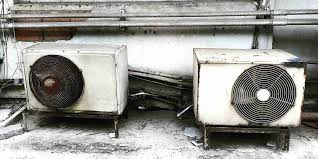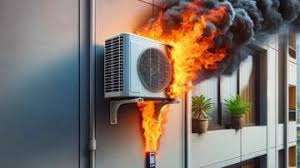Recent reports from Dhaka and other parts of Bangladesh have highlighted incidents described as “AC explosions,” causing injuries, deaths, and widespread concern among air conditioner users. However, investigations into several cases reveal that these incidents are often misattributed to air conditioners (ACs), with other sources like gas leaks or electrical faults being the actual culprits. This misinformation has fueled fear and confusion. This fact file aims to clarify these claims by examining the structure and operation of ACs, analyzing case studies, and addressing misconceptions.
How Air Conditioners Work
An air conditioner (AC) is a system designed to regulate temperature in a specific area. It’s critical in places like cold storage, hospital operating theaters, or pharmaceutical storage, where precise temperature control is essential. ACs are also widely used in homes, offices, shopping malls, and restaurants for comfort. Once considered a luxury, AC usage in Bangladesh has surged.
Types of ACs
- Split-Type ACs: The most common in homes, these have two units:
- Indoor Unit: Mounted inside, it releases cool air (in cooling mode).
- Outdoor Unit: Installed outside, it expels hot air.
- Connected by electrical lines and gas pipes, the indoor unit cools the room while the outdoor unit releases heat.
- Compact/Window/Portable ACs: Combine indoor and outdoor units, with cool air directed indoors and hot air expelled outside.
- Multi-Split ACs: Used in larger spaces like malls, with one outdoor unit connected to multiple indoor units.
ACs can operate in cooling mode (cooling indoor spaces) or heating mode (warming indoor spaces), with some models switching between modes for summer cooling or winter heating.
AC Components
- Indoor Unit: Wall-mounted, ceiling-mounted, cassette, or ducted, it handles air circulation.
- Outdoor Unit: Contains the compressor and expels heat.
- Refrigerant: A gas (e.g., R22, R410A, R134, R32, R290) that facilitates cooling. Most refrigerants (e.g., R22, R410A) are non-flammable, but some (e.g., R32, R290) are flammable, though used in small quantities (600-700g for a 1-ton AC, 1200g for a 2-ton AC, or 3000g for a 5-ton AC).
Can ACs Cause Fires or Explosions?
Fires require three elements, known as the Fire Triangle:
- Oxygen: Present in open environments where ACs operate.
- Heat: ACs generate heat in the outdoor unit (in cooling mode) or indoor unit (in heating mode), but they’re designed to withstand this. Overheating can occur due to:
- Overloading (e.g., using a 1-ton AC for a 200 sq ft room instead of 100 sq ft).
- Blocked airflow (e.g., curtains, plant pots, or debris obstructing the unit).
- Accumulated dust, requiring regular servicing.
- Fuel: AC components like metal are non-combustible, and plastics are minimal (100-200g). Electrical parts use fire-retardant materials. Refrigerants are the primary concern, but non-flammable ones (R22, R410A) don’t ignite, and flammable ones (R32, R290) are in small quantities compared to a 12.4kg gas cylinder (20 times more fuel).
ACs in Bangladesh mostly use non-flammable refrigerants, reducing fire risks. However, electrical faults or flammable materials nearby can ignite, often misattributed to the AC.
Can ACs Explode Without Fire?
AC compressors have pressure limits. Exceeding these (due to sensor failure or gas buildup from prolonged inactivity) can cause a compressor explosion. Gas bubbles or lubricant oil in compressor pipes can jam, leading to pressure buildup and explosions, potentially sparking fires if flammable materials are present. Jamming can cause loud noises, risking explosions if unaddressed.
Case Studies of Alleged AC Explosions
Misattributed Cases
- Narayanganj Mosque Explosion (September 4, 2020): Initially reported as an “AC explosion”, investigations revealed a gas leak from a faulty Titas Gas pipeline under the mosque. Closed doors/windows trapped gas, and a spark (not from the AC) caused the explosion. Eight Titas Gas employees were sacked and arrested.
- Mogbazar Explosion (June 28, 2021): Initially blamed on an “AC explosion”, investigations found 9% hydrocarbon gas (likely from a cylinder or pipeline) in the building, per Fire Service’s ex-DG Ali Ahmed Khan. IGP Benazir Ahmed confirmed methane gas accumulation.
- Comilla Drug Factory Explosion (April 7, 2021): Supervisors claimed an AC caused the explosion, but Kaler Kantho reported excessive chemical storage as the likely cause.
- Singapore Apartment Fire: A YouTube video titled “Air Conditioning Unit on Fire” showed flames from a window, but the AC’s outdoor unit was intact, indicating another fire source.

Confirmed AC-Related Fires
- United Hospital Fire (May 27, 2020): A fire in the COVID-19 isolation unit killed five patients. Witnesses saw smoke from the AC, and Fire Service’s Debashish Bardhan confirmed an old AC as the fire’s source, exacerbated by flammable hand sanitizers and oxygen.
- India AC Fire (April 20, 2015): A fire in an AC’s indoor unit at a State Bank of India branch in Agartala started from an electrical cable, spreading to the AC’s plastic parts. It was extinguished within minutes.

AC Repair Incidents
Nine cases involved technicians injured or killed during AC repairs, often due to compressor explosions in the outdoor unit:
- Sadharghat Launch Fire (March 27, 2022): Fire during AC repair.
- Swapna Super Shop (April 12, 2021): Compressor explosion injured two technicians.
- Old Dhaka (February 11, 2020): Compressor explosion killed one worker.
- Gulshan NCC Building (January 13, 2021): Technician Azizul died in an outdoor unit explosion .
- Cox’s Bazar Hospital (April 4, 2021): Technician Zahid injured in compressor explosion.
- Gulshan Hotel (November 7, 2014): Technician Anwar Hossain killed.
- Motijheel Market (June 1, 2018): Three workers injured in compressor explosion.
- Gazipur Bank (June 8, 2022): Two mechanics injured.
- Khulna Hospital (February 26, 2022): Two mechanics injured.
Ambiguous Cases
Twelve cases lacked sufficient evidence (photos or detailed reports) to confirm AC involvement:
- Sreemangal Railway Station (September 20, 2020): Reported as a compressor explosion, but photos showed the compressor intact, suggesting an external fire.
- Mirpur Office (March 20, 2019): Reported as a compressor explosion inside a room, but compressors are in outdoor units, making the claim questionable.
- Uttara Flat (March 19, 2019): A couple died, allegedly from an AC compressor explosion, but the compressor is outdoors, and a relative claimed broken glass allowed fire to enter.
- Gulshan Flat (October 27, 2021): Fire Service suspected an AC explosion, but a relative claimed an electrical transmitter explosion caused the fire.
- Meher Afroze Shaon’s Home (June 9, 2022): The actress blamed an AC explosion, but no evidence confirmed the AC as the fire’s source.
- BRAC University Student Death (June 19, 2022): Fire Service speculated an AC explosion or short circuit, but no evidence was provided.
- Uttara Motors DMD (June 19, 2021): Fire from an AC malfunction, but no photos were available.
- Other Cases (Motijheel NCTB, Mugda Hospital, Gulshan, Aftabnagar, Elephant Road): Lacked photos or detailed reports.
Misleading Media Reports
A recurring image used in AC explosion reports was traced to a YouTube video by Indus HVAC Services titled “Heat Mode AC Burn Damage | Air Conditioner Short Circuit Fire.” It showed two indoor units with fire damage from a short circuit, not an explosion. This image is misused to depict unrelated incidents.
How Common Are AC Explosions?
- Dr. Samanta Lal Sen from Sheikh Hasina Burn Institute told BDNews24 that AC explosion injuries have increased over three to four years.
- A Dhaka Tribune report noted 150 AC explosion incidents in Bangladesh over five years, but it’s unclear how many were actual AC explosions versus misattributed electrical or gas incidents.
- In the U.S., 1% of fires are AC-related, per industry data.
- Mechanical Engineer Pradeep Shah, with 60 years of experience, claims he’s never seen an AC explode (Quora).
- The American Academy of Forensic Sciences states compressor explosions are rare, with no recorded immediate deaths.
Conclusion
Of 28 case studies:
- 4 cases were misattributed to ACs (gas leaks or chemicals were the cause).
- 2 cases confirmed AC-related fires (United Hospital and India).
- 1 case involved a fire from an AC’s electrical cable, extinguished quickly.
- 9 cases involved technician injuries/deaths during repairs, often due to compressor explosions in outdoor units.
- 12 cases lacked evidence to confirm AC involvement.
FactWatch concludes that AC explosions are rare but possible, often due to compressor issues during repairs or improper use. Misinformation arises from public and media misunderstanding, mistaking electrical or gas incidents for AC explosions. ACs are not inherently more dangerous than other electronics and often have robust safety features.
Recommendations to Prevent AC Incidents
For Technicians
- Training: Many of Bangladesh’s 50,000 AC technicians lack formal training, per BUET’s Professor Majumder. Proper training can reduce risks.
- Safety Gear: Use adequate protective equipment and repair ACs in controlled workshop settings, not homes, to avoid rushed jobs.
For Users
- Prevent Fire Triangle:
- Choose ACs with non-flammable refrigerants (e.g., R22, R410A). Check the AC’s sticker or manufacturer’s website.
- Keep flammable materials (e.g., sanitizers, oxygen) away from ACs, as seen in the United Hospital case.
- Ensure technicians use non-flammable refrigerants and fire-retardant parts during servicing.
- Avoid Overheating:
- Install outdoor units in shaded, well-ventilated areas, avoiding direct sunlight or heat sources. Use canopies if needed.
- Regularly service ACs to clear dust from air filters and pathways. Ensure no curtains or objects block airflow.
- Consult engineers to select the right AC capacity (e.g., 2-ton for larger rooms). Undersized units overheat, increasing risks.
- Use fault-free electrical wiring to prevent short circuits, as many buildings have outdated systems (Fire Service).
- Additional Precautions:
- Turn off ACs during storms or lightning, as advised by BGB’s Lt. Col. Mofizur Rahman (Kaler Kantho).
- Use trusted brands and avoid low-quality or counterfeit ACs, per Walton’s Sandip Biswas.
- Prefer split-type ACs over window/portable units, which have higher risks (Insurance Lab).
- Keep water or CO2 fire extinguishers handy for electrical fires.
- Read the AC manual and follow maintenance guidelines.
By adhering to these measures, AC-related incidents can be minimized, ensuring safer usage in Bangladesh.



